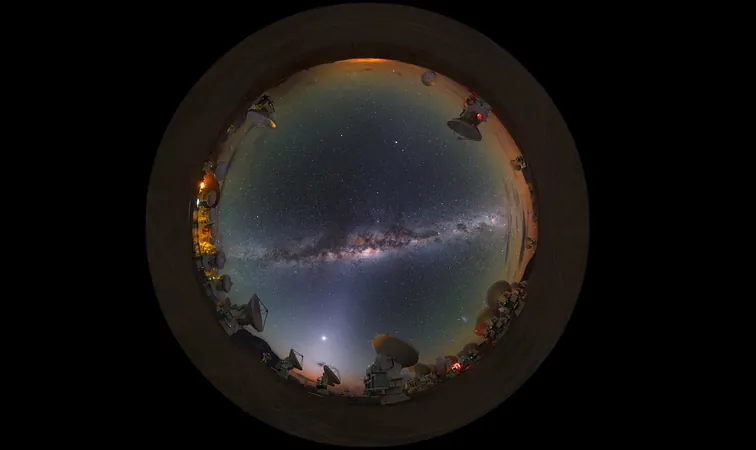
Why Vega Claims the Title of the Second Most Crucial Star in Our Sky
2024-12-28
Author: Yu
Introduction
Have you ever gazed up at the night sky and wondered what lies beyond our familiar Sun? Many would point to Vega, a star that, over centuries, has earned the reputation of being "the most important star in the sky after the Sun." But what is it about this celestial giant that makes it so remarkable? Astoundingly, its characteristics challenge centuries of astronomical comprehension.
Vega in the Night Sky
Currently, if you look to the northwest post-sunset, you'll spot Vega shining brightly within the constellation Lyra. This ancient constellation, described by the Greek astronomer Ptolemy nearly 2,000 years ago, has various names across cultures—from the eagle in Arabic folklore to King Arthur’s harp in Welsh mythology. Vega is not just a spark in the night; it's the sixth-brightest star visible from Earth and was once the North Star around 14,000 years ago. It is destined to reclaim that title in approximately 12,000 years.
Historical Significance of Vega
Vega's brightness isn't the only reason it's captured the attention of astronomers. Back in 1850, it became the first star ever photographed, and a mere 22 years later, it also became the first star to have its spectrum captured, marking significant milestones in astrophysics.
Vega as a Standard for Brightness Measurement
Vega's greatness extends beyond its historical significance; it has served as a fundamental standard for measuring the brightness of other celestial bodies for over a century. This remarkable status solidifies its claim as "the most important star in the sky after the Sun." However, the arbitrary nature of standard measurements can lead to complications.
Challenges in Standard Measurements
Consider a scenario where we used a thumb’s length or a grain of barley for measuring—these references may become impractical in various locales. Instead, more universally applicable standards achieved through scientific consensus are crucial. Vega’s importance in our cosmic measurement toolkit can be traced back to the system designed by Hipparchus, who categorized stars based on their brightness in the 2nd century BCE. He assigned the brightest stars a magnitude of 1 and the faintest a magnitude of 6, leading to an unusual scale where brightness declines as the magnitude increases.
Vega's Variability and the Brightness Scale
Astrophysicists established that Vega possesses a magnitude of 0, thus normalizing the brightness scale. However, this status faced challenges over the years. Vega is known for its slight variations in brightness—ranging up to 10% due to its rotation—making it a less stable reference point.
Vega's Dust Disk and Its Significance
In a groundbreaking twist, researchers discovered two decades ago that Vega is encircled by an enigmatic dust disk. At around 450 million years old, Vega may seem relatively youthful compared to our Sun, but it’s larger and will ultimately exhaust its energy reserves far sooner. Astonishingly, Vega's dust disk comprises particles primarily containing silicon and carbon, forming a peculiar structure devoid of sizable planets—contrasting starkly with our solar system.
Exploration of Vega's Enigmatic Surroundings
The disparities in Vega's dust disk, with its homogeneous nature and absence of massive planetary bodies, pose questions about stellar formation processes. Researchers at the James Webb Space Telescope are unveiling the nuances of this strange disk, suggesting a history rich with collisions among planetesimals.
Conclusion
Vega's transition from fundamental brightness standard to a more intriguing subject of study underscores the evolving tapestry of astronomy. Still relevant in today’s cosmic narrative, Vega invites us to explore not just its lingering influence on measurements but the captivating secrets hidden in its surrounding dust. As we continue to probe the depths of our universe, Vega stands as a beacon—a star whose story is far from over. So, next time you look up, remember Vega isn’t just a star; it’s a symbol of our unending curiosity and quest for knowledge beyond our earthly bounds. What fascinating revelations might we uncover next?


 Brasil (PT)
Brasil (PT)
 Canada (EN)
Canada (EN)
 Chile (ES)
Chile (ES)
 Česko (CS)
Česko (CS)
 대한민국 (KO)
대한민국 (KO)
 España (ES)
España (ES)
 France (FR)
France (FR)
 Hong Kong (EN)
Hong Kong (EN)
 Italia (IT)
Italia (IT)
 日本 (JA)
日本 (JA)
 Magyarország (HU)
Magyarország (HU)
 Norge (NO)
Norge (NO)
 Polska (PL)
Polska (PL)
 Schweiz (DE)
Schweiz (DE)
 Singapore (EN)
Singapore (EN)
 Sverige (SV)
Sverige (SV)
 Suomi (FI)
Suomi (FI)
 Türkiye (TR)
Türkiye (TR)
 الإمارات العربية المتحدة (AR)
الإمارات العربية المتحدة (AR)